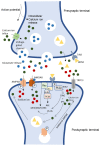The potential neuroprotective effects of stingless bee honey
- PMID: 36846103
- PMCID: PMC9945235
- DOI: 10.3389/fnagi.2022.1048028
The potential neuroprotective effects of stingless bee honey
Abstract
Tropical Meliponini bees produce stingless bee honey (SBH). Studies have shown beneficial properties, including antibacterial, bacteriostatic, anti-inflammatory, neurotherapeutic, neuroprotective, wound, and sunburn healing capabilities. High phenolic acid and flavonoid concentrations offer SBH its benefits. SBH can include flavonoids, phenolic acids, ascorbic acid, tocopherol, organic acids, amino acids, and protein, depending on its botanical and geographic origins. Ursolic acid, p-coumaric acid, and gallic acid may diminish apoptotic signals in neuronal cells, such as nuclear morphological alterations and DNA fragmentation. Antioxidant activity minimizes reactive oxygen species (ROS) formation and lowers oxidative stress, inhibiting inflammation by decreasing enzymes generated during inflammation. Flavonoids in honey reduce neuroinflammation by decreasing proinflammatory cytokine and free radical production. Phytochemical components in honey, such as luteolin and phenylalanine, may aid neurological problems. A dietary amino acid, phenylalanine, may improve memory by functioning on brain-derived neurotrophic factor (BDNF) pathways. Neurotrophin BDNF binds to its major receptor, TrkB, and stimulates downstream signaling cascades, which are crucial for neurogenesis and synaptic plasticity. Through BDNF, SBH can stimulate synaptic plasticity and synaptogenesis, promoting learning and memory. Moreover, BDNF contributes to the adult brain's lasting structural and functional changes during limbic epileptogenesis by acting through the cognate receptor tyrosine receptor kinase B (TrkB). Given the higher antioxidants activity of SBH than the Apis sp. honey, it may be more therapeutically helpful. There is minimal research on SBH's neuroprotective effects, and the related pathways contribute to it is unclear. More research is needed to elucidate the underlying molecular process of SBH on BDNF/TrkB pathways in producing neuroprotective effects.
Keywords: anti-inflammatory; antioxidant; brain-derived neurotrophic; epileptogenesis; neuroprotective; stingless bee honey; tyrosine receptor kinase B.
Copyright © 2023 Zulkifli, Hassan, Mustafa, Azman, Hadie, Ghani and Mat Zin.
Conflict of interest statement
The reviewer SLT declared a past co-authorship with the author SNHH to the handling editor. The authors declare that the research was conducted in the absence of any commercial or financial relationships that could be construed as a potential conflict of interest.
Figures

References
Publication types
LinkOut - more resources
Full Text Sources

